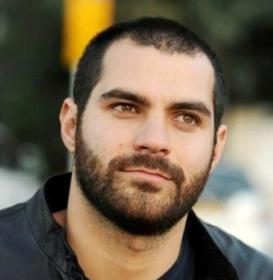A simple story
Amichai Chasson
 שי עגנון - Israeli GPO photographer ויקיפדיה
שי עגנון - Israeli GPO photographer ויקיפדיה
Amichai Chasson explains how Shai Agnon's book found itself in the prayer canon for the Days of Awe
The most important mathematics I learned as a child was acquired in synagogue, during the Yom Kippur prayers. I would obsessively count the number of pages left until the end of prayer, and calculate the hours until the beginning of the meal. It wasn’t easy for a child to calculate: our synagogue skipped certain verses, some verses were recited slower than others, and the Rabbi’s sermon was a riddle whose duration could not be guessed. I counted pages with my finger, and performed feats of adding and subtracting, multiplying and division. I practiced my arithmetic on the prayer book as my stomach growled hungrily. When I grew up, God gave me what I was due and I only barely squeaked by my math matriculation exam. There is a judge in heaven.
Besides counting the pages, I liked watching the faces of the adults as they prayed. Some listened intently to the cantor, enjoying every trill and not missing a beat. Others chatted, and yet others looked for some alternative text to cling to. They read the Gemarot or studied the brochures handed out in the synagogue, offering cheap bible verses that decorate ads for vacations in the Swiss Alps.
As a boy I learned the trick: a Jew needs another book besides the prayer book to get through the long hours spent in synagogue. I would slide a book into my cloth tallit bag and open it up on the stand next to the prayer book. One eye would follow the cantor and the congregation while the other read “Days of Awe” by Shai Agnon.
Unlike myself, Agnon, the only Israeli author to win a Nobel Prize for Literature to date (in 1966), described his childhood memories of the synagogue in Buchach in the most romantic colors possible. “The skies were pure and the land peaceful and the streets were clean, and a new wind would flutter in the space of the world,” beings his second introduction to the book, “and I was a four year old baby, dressed in holiday clothing, and my relatives walked me with my father and grandfather to the House of Prayer. And the synagogue was filled with men in prayer shawls and silver decorations, their cloths white and the books in their hands, and many candles were planted in long boxes of sand, and a wondrous light and a good smell emanating from them.”
The description goes on, along with the sacred awe of the boy who Agnon was (back then he was still Shmuel Yosef Tschatshkes) – a primitive religious emotion. But gradually, the prayer stops and pauses, and the little boy bursts into tears. He doesn’t tell the adults around him why he is crying, and this is revealed only to his readers, about 50 years later:
“When the prayer stopped, that beauty ended. Some of the people removed the shawls from their heads and some began talking to each other. Those whom I loved had suddenly changed their faces, their beautiful countenances replaced with their daily figures of home and life. And that is what rend my heartstrings, that is why I cried.”
The people he had momentarily seen as angels were now revealed in their humanity, as people who could be a little bored on the Highest Holy Day. However, Agnon writes later on, “Some do not distract themselves even for a moment from the sacredness of the day, but what can the simple man do, he who has not the strength to constantly remain on that degree in which he is one with his maker?”
Well, Agnon not only asks, but answers. Like any shrewd Jewish merchant, Agnon has the remedy in his shirt pocket: in the book “Days of Awe, an Anthology” (or: “an epic poem about the love of the High Holy Days”, as the author put it), which is a collection of sermons, stories and legends about this holy time, so that “a person can read the book during the breaks, between prayers, and stimulate his heart.” Not, God forbid, count the pages in the prayer book or look idly at the travel brochures in the synagogue. Today, if it wasn’t forbidden to use electricity on holy days, Agnon’s idea would have made a great smartphone app.
But truth is, the idea wasn’t originally Agnon’s, and like many other details in his life (like his invented and symbolic date of birth), here too the great author appropriated the myth and phrased it as a nice story. The idea for the anthology was put forth by the manager of Shocken Publishing house in Germany in the 1930’s, Dr. Moshe Spitzer. Agnon, on his part, spent two and a half years completely dedicated to editing the book. He reviewed about one thousand books and collected the many materials for the book, while adapting them to his time, comparing wordings, translating from Aramaic, consulting with his Rabbi (Prof. Samuel Bialoblotzky) and dividing them into three parts: Rosh Hashana, Ten Holy Days, and Yom Kippur.
In his introduction he wrote, in a manner reminiscent of the chaotic alarms we have seen this past year, “I often had to suddenly stop my work and turn off the lamp in the middle of the night, forced to flatten myself on the floor in order to avoid the danger of the bullets that were fired just outside my home.”
The first edition of the book was published just before Rosh Hashana in 1938 and was distributed as a holiday gift for subscribers of “Haaretz” by the publisher, Agnon’s financial patron, Zalman Shocken. The book received almost immediate acclaim and became a legitimate text to read in synagogues during prayer, even in the traditional congregations.
Agnon, mischievous as always, managed to realize some of his heart’s desires and situate himself among equals within the holy books. To “Days of Awe”, he added some texts from an allegedly primitive book called “Sermons of the Voice of God”. Prof. Gershom Shalom, a great Kabbala scholar and close friend to Agnon, ascribed the act to Agnon’s “somewhat sarcastic sense of humor” and clarified that the book was not real. The sermons within in are none other than Agnon’s own.
We can also learn how important it was for Agnon to penetrate the synagogue from other Biblical anthologies he edited, such as the book “Present at Sinai” (about the giving of the Bible) and books of Hassidic tales. Journalist and author Adam Baruch wrote in his books about how Agnon tried to include his books in the biblical library belonging to Baruch’s grandfather, head of Meah Shearim Yeshiva, as Agnon considered his works to take a legitimate place in the biblical canon. According to Baruch, at least in the case of his grandfather, these attempts were futile. Incidentally, Agnon did manage to infiltrate the synagogue through another route – as one of the writers of the prayer for Israel, along with then Chief Rabbinates Herzog and Uziel.
In recent years, other books have been added to “Days of Awe” as legitimate alternatives to the well-known prayer. There are the interpretations and amendments edited by Dr. Daniel Goldshmidt and Prof. Yona Frenkel, and even initiatives like “Our Prayer”.
The most popular of all must be the books “From you to Me”, edited by poet Yonadav Kaplon. These books have been printed in the tens of thousands as part of the “People of the Word” series by Yedioth Ahronot, and have become the default for many congregants. Unlike Agnon, Kaplon stuck to the original text, but added stories and interpretations that extend the discourse. He also chose to add modern religious thinkers such as Rabbi Yosef Dov Halevy Solobeytzek and Prof. Yishayahu Leibowitz, and even some modern Hebrew poetry, from obvious names like Zelda to surprising ones like Dalia Rabikowitz.
The only problem with these newer books is that after several years, even their texts become worn and familiar, and the desire to count the pages returns. And perhaps here is a challenge for the modern publisher: there is plenty of room and many sources for many new kinds of prayer books.
I too threw my lot into this bonfire: “Company Needed for the Holiday Season” is an anthology of short stories I edited for the High Holy Days, which was published by Indiebook. It was published only in a digital version, and truthfully, for Orthodox Jews it’s a problem, because they can’t take it to synagogue. But it too is an attempt to respond to the needs of our time, with the help of writers such as Galit Dahan Karlibach, Moran Shuv, Kobi Ariely, Mati Shmueloff and others. Yair Agmon begins the opening story with a paraphrase on Agnon’s famous introduction to “Days of Awe”, but for Agmon, “the skies were thick, dark, and murky, the land was peaceful and the streets were clean.”

צילום - מוטי קיקיון ויקיפדיה






